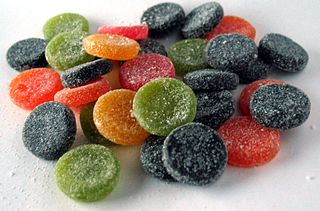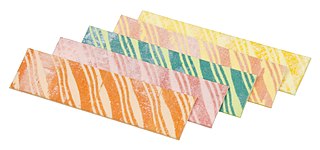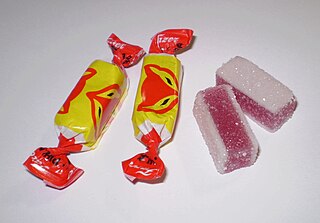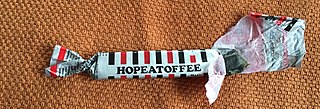
Marmalade is a fruit preserve made from the juice and peel of citrus fruits boiled with sugar and water. The well-known version is made from bitter orange. It is also made from lemons, limes, grapefruits, mandarins, sweet oranges, bergamots, and other citrus fruits, or a combination. Citrus is the most typical choice of fruit for marmalade, though historically the term has often been used for non-citrus preserves.

Gummy bears are small, fruit gum candies, similar to a jelly baby in some English-speaking countries. The candy is roughly 2 cm (0.8 in) long and shaped in the form of a bear. The gummy bear is one of many gummies, popular gelatin-based candies sold in a variety of shapes and colors.

Nerds is an American candy launched in 1983 by the Sunmark Corporation under the brand name Willy Wonka Candy Company. Nerds are now made by the Ferrara Candy Company, a subsidiary of Ferrero Group. but is still distributed internationally by Nestlé. With their anthropomorphic covers, Nerds usually contain two flavors per box, each flavor having a separate compartment and opening.
Finlandia is a symphonic poem by Jean Sibelius.

Starburst is the brand name of a box-shaped, fruit-flavoured soft taffy candy manufactured by The Wrigley Company, which is a subsidiary of Mars, Incorporated. Starburst has many different varieties, such as Tropical, Sour, FaveREDs, Watermelon, Very Berry, Superfruit, Summer Blast and Original.

Pantteri, sold in Sweden as Katten, is a brand of Finnish salmiakki candy, made by Fazer.

Swedish Fish is a fish-shaped, chewy candy originally developed by Swedish candy producer Malaco in 1957 for the U.S. market. They come in a variety of colors and flavors.

Fruit Stripe was an artificially and naturally flavored fruit chewing gum produced by Beech-Nut in 1960 and discontinued in 2024. The individual pieces of gum were striped and were packaged in zebra-striped wrappers, which also acted as temporary tattoos.

Farley's & Sathers Candy Company was created as an umbrella company to roll up many small companies, brands and products under a common management team. The confectionery business segment is made up of many small companies, often with intertwined relationships and histories.
Flintstones Chewable Vitamins are a supplemental multivitamin for children, shaped like the characters of the animated sitcom The Flintstones. They were introduced in 1968 by Miles Laboratories and taste sweet like candy. Miles Laboratories was acquired by Bayer in 1979.

Gummies, gummi candies, gummy candies, or jelly sweets are a broad category of gelatin-based chewable sweets. Gummy bears, Sour Patch Kids, and Jelly Babies are widely popular and are a well-known part of the sweets industry. Gummies are available in a wide variety of shapes, most commonly seen as colorful depictions of living things such as bears, babies, or worms. Various brands such as Bassett's, Haribo, Albanese, Betty Crocker, Hersheys, Disney and Kellogg's manufacture various forms of gummy snacks, often targeted at young children. The name "gummi" originated in Germany, with the terms "jelly sweets" or "gums" more common in the United Kingdom.

The Mignon chocolate egg is an Easter confectionery made by the Fazer company. Its distinctive features are a filling of almond-hazelnut nougat inside a real eggshell. The Mignon is the second oldest Fazer product, dating back to 1896, when Karl Fazer brought the recipe from Germany.

Pirate coins are salty liquorice flavoured candies popular in Europe, especially the Nordic countries. The candies are coin-shaped and feature images associated with pirates, such as guns, skull and crossbones symbols, and parrots.

Pihlaja, also called kettukarkki is a marmalade candy produced by the Finnish food corporation Fazer. Fazer started producing the candy in 1895 at the patisserie on Kluuvikatu, Helsinki, making it the oldest candy produced by Fazer still on the market. The candy's recipe has changed over time. The candies are wrapped in a yellow-red paper with a red illustration of a fox. Pihlaja is lactose free and mostly gluten free.

Marianne is a Finnish mint chocolate candy originally developed in 1949 by Chymos, now produced by Fazer. Marianne candies have a hard peppermint-flavoured shell and a chocolate filling.

Chymos Oy was a Finnish company founded in 1906, producing juice, jam, wine, liqueurs and candy. In 1993 the company's candy production was bought out by Fazer, and in 2006 Chymos was fully assimilated into Cloetta Fazer.

Vihreät kuulat is a brand of pear-flavoured gummy candies produced by Fazer, sold in boxes and as loose candy. The Finlandia candy selection includes spheres of other colours as well.

Hopeatoffee is a Finnish brand of candy bar, originally launched by Hellas, with a salty liquorice and toffee flavour. Production of Hopeatoffee started in the 1970s, and the candy was a new innovation at the time, as salty liquorice had not been combined with toffee before.

Aakkoset is a Finnish brand of candy sold in Finland since 1970, currently sold by Cloetta under the Malaco brand name. The name "Aakkoset" comes from the various capital letters of the alphabet decorating the lozenge-shaped candies.

















